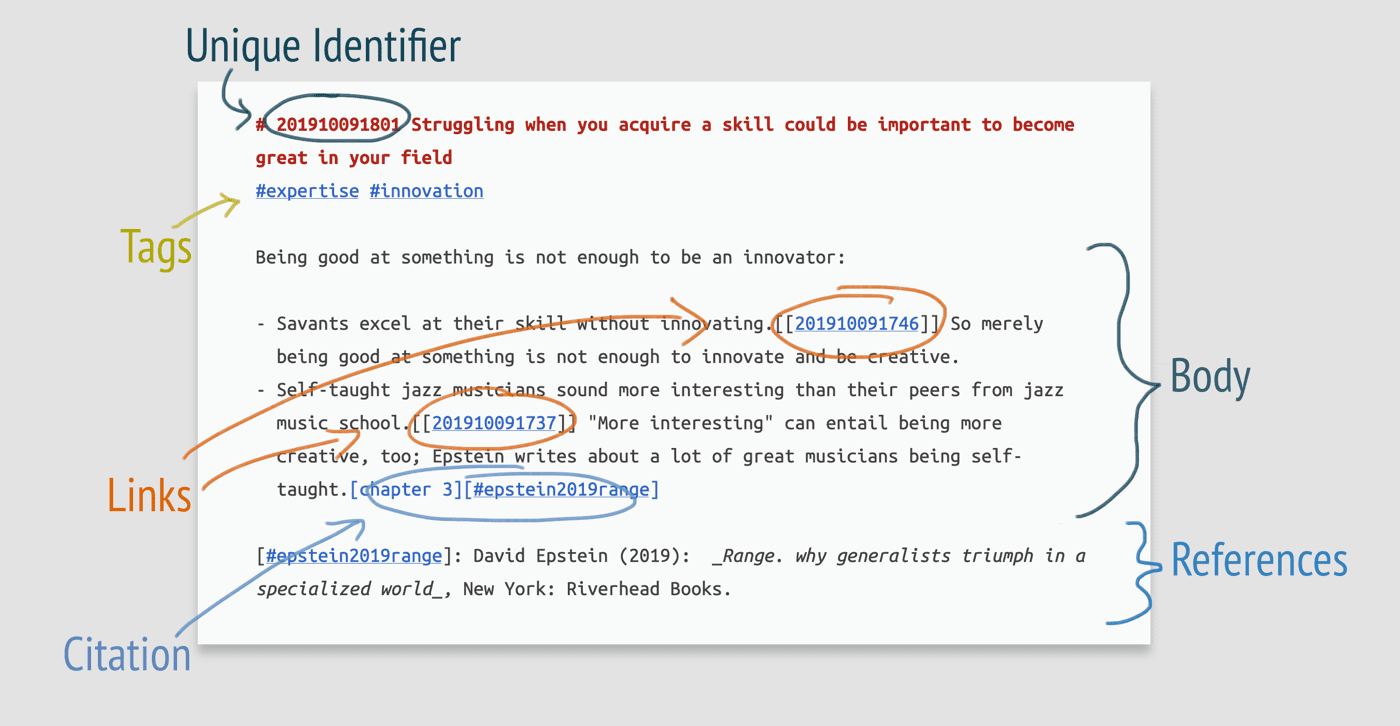Note Taking Methods
PARA Method
Link to notes.
Projects, Areas, Resources, and Archives.
Projects: Short term efforts in your work or life that you’re actively working on
Think of the things you want to accomplish in the short-term. A few days to a few weeks of effort. Think:
- Completing a coding project (website, utility)
- Purchase a new computer/phone/tv
- Reorganize your room/locker
- Finishing a school project
Area: Long-term responsibilities you want to manage over time
A broad approach that can be interpreted in a few different ways. Think of the important parts of your work and life that require ongoing attention:
- School responsibilities like managing a team, or president of a club
- Personal responsibilities like health, self-improvement, investments
Resource: Topics or interests that may be useful in the future
Resources make up the hobbies you want to spend your free time on. These notes are where you update and keep track of your progress as you learn more. Think:
- Graphic Design
- Music Production
- Video Production
- Language learning
- Bodybuilding
Archive: Inactive items from the other three categories
As information begins to become less relevant, or a project is completed, you can filter all the notes into a larger archived folder. You can even take it a step further and tag them as archived.
Zettelkasten
Link to notes.
“…a holistic method on how to deal with knowledge in your life.” - Zettelkasten Introduction
The introduction to Zettelkasten mostly explores how beneficial and time saving it will be to your workflow. To not come off too much like they do, I’ll just go over the pertinent points that make this system of note taking unique as they introduce them.
Zettelkasten is an object, or rather a larger book or text of reference filled with Zettels, or paper-slips in German. Each Zettel has a unique identifier, that is either entirely unique if not related to some note, or a continuation of the exisiting naming convention if a related note already exists.
The second feature is the Principle of Atomicity, or keeping each note about one core concept or thought. There is no mistaking what the note is about; it has one goal and one concept per note.
The third is simply put; to each their own. One Zettelkasten per person, and one person per Zettelkasten. Since everyone takes notes differently, it only makes sense that one would not be able to benefit from using someone else’s notetaking system.
The Anatomy of a Zettel
Each Zettel is broken down into three main areas;
- Unique Identifier
- Body/Content
- Footer/Reference
The unique identifier can be made in a few different ways. The most common are a Luhmann-ID (named after the guy who popularized Zettelkasten method) where you use an arbitrary hierarchy like letters than numbers than sub numbers, or a Time-based ID where the date and time of the creation of the Zettel indicate it.
The body of the Zettel should come from you, as the main concept of the note taking is that it should be written in your own words. Using a quote as a quote is no issue, but it should be relevant to how you’re building your Zettelkasten.
On the topic of the content, they do go into detail on how you as the creator shouldn’t feel adverse to starting a note you might never use or come back too. They use the examples of the type of person you are and the objective of your Zettelkasten; move at the pace of your goals. If your goals are long term, enjoy the process and experiment. If your goals are short-term and require immediate attention, focus and lock-in.
For me personally, I have no rush to switch or change career paths. I’m decently comfortable in my teaching position, and really want to focus on keeping my own version of a Zettelkasten (my Obsidian vault) interesting and useful for not only myself but also my students.
The reference section is for your external links like books or online articles. Notes with no references are therefore notes based on your own thoughts or ideas.
Cornell Notes
Link to notes.
A rather simple method compared to the first two, but also a different end goal. Where the PARA and Zettelkasten method exist as ways to organize your notes, Cornell methodology is exactly how to take down notes.
Primarily meant to be written on paper (probably in your notebook) you break the page down into three sections; notes, cues, and a summary.
The notes section should be a bulk of the page, where you write down all the facts and direct information you learn as you read some text, book, or lesson.
The cue section should be alongside your notes section for interjections on your end. Questions you might have for later you want to save or ask the teacher/professor later, or just a point you want to revisit later for clarification.
The summary at the bottom is self-explanatory: a section written in your own words to summarize everything you’ve learned from your note taking session.
How I Take Notes
I guess you could say I use a little bit of each method when creating my own notes. I definitely use mostly a Zettelkasten approach to my notes, they aren’t exactly fleeting. Some of my notes are hundreds if not thousands of words long. I don’t expect those to count as simple one thought notes.
I don’t really keep to the PARA method either. My notes are too spread out to exist within 4 frameworks, and I don’t have any method of archiving any of the notes. So far since using Obsidian, I haven’t deleted any notes. I do think one day I’ll shorten some of my notes to make accessing information easier, I’m not in a rush and do enjoy the process of writing even if it’s not as optimized as it could be.
